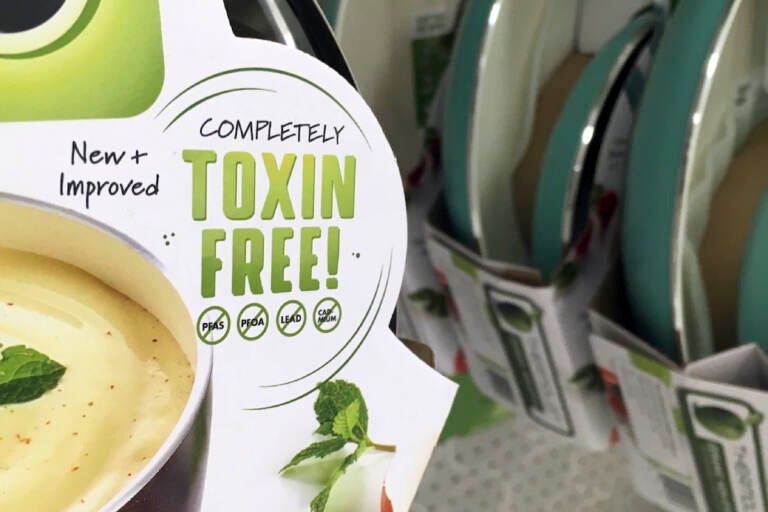Besides water, how else am I exposed to PFAS?
Clothing, carpeting, even microwave popcorn bags may have been manufactured using some members of this toxic class of chemicals.
Listen 2:17
In this June 17, 2019, file photo in Washington, a label states that these pans do not contain PFAS, perfluoroalkyl and polyfluoroalkyl substances. (AP Photo/Ellen Knickmeyer, File)
More and more people are aware of the health risks of exposure to the toxic compounds known as PFAS, particularly through drinking water contaminated when the chemicals got into groundwater. But there are other ways to be exposed — including through commonly used household items.
Some PFAS (per- and polyfluoroalkyl substances) have been phased out by manufacturers. But advocates say consumers should be aware they’re still out there.
“You’re exposed to PFAS in popcorn bags, and pizza boxes … and your clothing that you wear — if it’s rain gear, there’s a high chance that it has a coating on it that is a certain type of PFAS. There’s clothing brands — expensive clothing brands — that are still made with a type of PFAS compound,” said Vikki Prettyman of Southeast Rural Community Assistance Project Inc. in Delaware, which helps people get access to clean drinking water and provides free testing.
“When we go to test the water for PFAS, there’s listed brands and types of clothes that we can’t wear when we do test the water, because we can’t cross-contaminate the water samples with potentially something that we have on,” she said. “So it is very complicated, and you just have to make sure you do it right — but it’s worth doing right, because we’re talking about the health and safety of our citizens.”
For decades, PFAS have tainted the water, air, and soil in this region and across the country. These so-called “forever” chemicals, which don’t break down naturally in the environment, also have been widely used in products such as nonstick cookware and flame-retardant fabrics, as well as in firefighting foam used at current and decommissioned military bases. The contamination has had a significant impact on residents in areas such as Bucks and Montgomery counties in Pennsylvania, Monmouth County in New Jersey, and Dover and Blades in Delaware.
The numerous health problems, including some cancers, linked to PFAS have led to lawsuits against companies that make the products, such as DuPont and its successor companies, and 3M. Bucks County filed a similar lawsuit last week.
Towns, counties, and states have worked to eliminate PFAS in drinking water, and efforts to set maximum contaminant levels are underway in Pennsylvania Delaware. (New Jersey already has such an enforceable standard.) The Environmental Protection Agency last year announced a roadmap to address PFAS. However, the consequences of exposure are long-lasting — the compounds can stay in the human bloodstream for years.
What products in my home might contain PFAS?
In addition to pizza boxes, microwave popcorn bags, and nonstick cookware, grease-resistant paper and stain- or water-repellent clothes, carpets, or fabrics may contain certain PFAS compounds.
How do I know if a product contains PFAS?
“If your pizza doesn’t stick to it, it very well might. And just by looking at it, you may not be able to completely tell just by eye. But generally, if it is a non-stick type product, it may contain a chemical that is used to create that,” said Dr. Richard Hamilton, chair of emergency medicine at Drexel University College of Medicine. “Whether it contains PFOA or PFOS, or whether it contains some of the newer versions, it can be difficult to sort out.”
Should I be worried about consumer products?
The PFAS that are most troubling to people’s health are largely being phased out, Hamilton said, and there’s been a general decline in PFAS exposure. You should be more concerned with PFAS contamination in drinking water than in household products, he said.
“We can limit our exposure or the amount of time that food stays in contact with containers or whatnot. And, with some very basic hygiene, avoid dust particles that contain PFAS from clothing or fabric,” he said. “But we’ve got to drink water. And so I’d be more focused on water quality than worrying about PFAS in your diet.”
Dietary consumption can be another concern, though. For example, in November, Maine issued a “do not eat” advisory for deer harvested in the area of Fairfield. Certain farm fields have been contaminated by the spreading of municipal or industrial sludge for fertilizer that contained PFAS, said Asa Lewis, a doctoral researcher at Drexel University’s College of Engineering. He’s part of a team studying PFAS, and is working on technology to eliminate it from water.
Lewis said if PFAS aren’t regulated or tested, people can consume them from agricultural sources.
“I think it’ll be difficult to find farms that you could guarantee that there’s no PFAS in some of the fertilizers they’re using,” he said.
How can I avoid PFAS?
When it comes to drinking water, the experts advise private well owners to test their water frequently and install a filtration system. Those who get their water from public supplies should ask their providers about their testing results.
Consumers can look for products labeled PFAS-free, Lewis said. You can follow this general rule: “Anything that’s been marketed or promoted as nonstick or water and oil resistant has the potential to contain PFAS,” he said.
Prettyman said all it takes is a Google search to find out which items are PFAS-free and which to avoid. She even pops her own popcorn to avoid microwavable packages.
“As a consumer, you just go, ‘Wow, I’m exposed in one shape or form. And it gets overwhelming,” she said. “We should now be more conscious of that nowadays because we’re just finding out more and more of what’s going to hurt us. But then we shouldn’t be living in fear either.”
What companies are eliminating PFAS?
According to saferchemicals.org, fast-food and fast-casual restaurants such as Chipotle, McDonald’s, Panera Bread, and Wendy’s have promised to reduce or eliminate the entire PFAS class from some or all of their consumer-facing food packaging. Grocery stores such as Albertsons, Trader Joe’s, and Whole Foods Market have made similar commitments, the website states.
Home Depot and Lowe’s also are phasing out the sale of carpets and rugs with PFAS.
Staples has named PFAS in disposable foodware, furniture, and textiles, and IKEA restricts the use of PFAS in textile materials in its products.
Though makers of outdoor gear have been slower to phase out PFAS products, efforts are underway. Patagonia, for instance, said 85% of its garments will be PFAS-free by the end of 2022.
WHYY is your source for fact-based, in-depth journalism and information. As a nonprofit organization, we rely on financial support from readers like you. Please give today.








